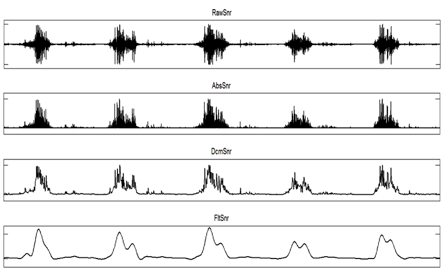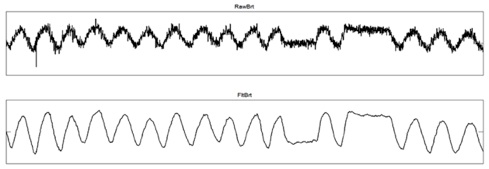Monitoring the signs of poor sleep quality
Recognition of sleep patterns is very important for numerous reasons such as the treatment of sleep disorders and the assessment of sleep quality. DreamSleep, a wearable sleep sensor, is developed to monitor sleep patterns in a more comfortable way. It is composed of two different parts: i) a wearable sleep sensor and ii) an Android application.
The wearable sleep sensor is to be attached to the user’s abdominal area. Then it senses user movements and snoring sounds to recognize sleep status. Main features of the application include visualization of sleep patterns, database for sensing data, and Bluetooth communication.
Technical Details - Sleep Disorders Detection
The finite impulse response – low pass filter (LPF) is commonly applied to reduce high frequency noise, then the knowledge based rule is utilized to detect sleep disorders. In the case of snoring detection, morphological conversion/transformation of the raw wave signal into a more robust signal that is easy to process is adopted.
Figure 1. Snoring waveforms
The microphone sensor output amplitude is varied according to the user’s snoring. As Fig 1 describes the sample snoring waveforms, the Absolute snoring signal (AbsSnr) can be derived by taking the absolute value from the raw snoring signal (RawSnr). The decimation process is applied to AbsSnr to reduce the amount of data. Finally, the decimation snoring signal (DcmSnr) passes LPF (cut off frequency: 50Hz), then the knowledge (interval, adaptive threshold) based peak detection algorithm is applied to detect snoring.
Figure 2. Breathing waveforms
As the user breathes during sleep, the abdominal region repeatedly, expands and contracts. Accordingly, the output signal of the z-axis accelerometer, attached on the abdominal area is also changed, as Fig 2 presents the sample breathing signal. LPF (cut off frequency: 10Mz) is applied to the raw breathing signal (RawBrt), then knowledge based criteria (threshold, time, amplitude) are adopted to determine the unchanged section in the filtered breathing signal (FltBrt). An unchanged section of more than 10 seconds is regarded as an apnea.
Figure 3. Toss & Turn waveform
When the user tosses and turns, his entire body rotates to the left or right side. The output signal of the y-axis accelerometer is therefore changed, as the body rotates. If the body rotates to the right or left side, the output signal has a plus or minus value, respectively. Thus, the filtered ‘toss and turn’ signal (FltTst) value changes.
Form Factor
Form factor of the wearable sleep sensor




